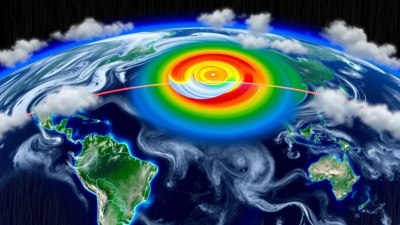What the ITCZ Is and Why It Drives Global Rainfall
Learn how the Intertropical Convergence Zone (ITCZ) influences global rainfall patterns and impacts climate, agriculture, and ecosystems worldwide.

The Intertropical Convergence Zone, commonly referred to as the ITCZ, is a crucial atmospheric feature that plays a dominant role in the global climate system. Spanning the equatorial region, this band of low pressure is responsible for driving much of the world's rainfall and shaping weather patterns across tropical and subtropical regions. Understanding what the ITCZ is and why it so strongly influences rainfall provides valuable insights into climate dynamics, ecosystem health, and human livelihoods.
At its core, the ITCZ is a narrow belt around Earth near the equator where the trade winds from the Northern and Southern Hemispheres converge. These converging winds push warm, moist air upwards, leading to condensation in the atmosphere and the formation of clouds and precipitation. This continuous cycle makes the ITCZ one of the most active rain belts on the planet, often referred to as the world's rainmaker.
Formation and Location of the ITCZ
The ITCZ forms primarily because of the intense solar heating at the equator. Solar energy is most concentrated here because the sun’s rays strike this region more directly year-round compared to higher latitudes. This concentrated heating causes the surface air to warm, become lighter, and rise in a process known as convection. As the warm air rises, it cools, causing water vapor to condense into clouds and then precipitation.
Meanwhile, from both hemispheres, prevailing easterly trade winds meet near the equator. These winds typically blow from the northeast in the Northern Hemisphere and from the southeast in the Southern Hemisphere. When these winds meet, the converging airflow forces the warm, moist air upward, intensifying the convection process. This convergence zone shifts seasonally with the movement of the sun, generally migrating north during the Northern Hemisphere summer and south during the Southern Hemisphere summer.
Key Meteorological Processes in the ITCZ
Two major atmospheric processes dominate the ITCZ’s behavior: convection and convergence. Convection involves the vertical movement of warm, moist air rising from the surface. As this air ascends, it expands and cools, leading to condensation at higher altitudes and the formation of towering cumulonimbus clouds, which frequently produce thunderstorms and heavy rains.
Convergence is the horizontal inflow of air towards the ITCZ zone. The opposing trade winds from both hemispheres funnel moisture-laden air into this region, concentrating heat and humidity. The combined effect of these processes results in intense precipitation and a humid climate along the ITCZ band.
Seasonal Shifts and Variability
The ITCZ does not remain fixed; instead, it migrates seasonally following the Sun's zenith point. From roughly November to February, the zone shifts southward, while from May to August, it moves northward. This migration influences rainfall patterns in tropical regions and drives wet and dry seasons. For example, countries in West Africa and South Asia experience monsoons largely due to the northward migration of the ITCZ, resulting in their rainy seasons.
The latitude of the ITCZ's migration, however, depends on a variety of factors, including the distribution of land and sea, ocean currents, and geographic features such as mountain ranges. This explains why some regions experience prolonged wet or dry conditions based on how readily the ITCZ moves over or around them.
The ITCZ’s Role in Global Rainfall Distribution
The ITCZ significantly influences where and when rainfall occurs worldwide. By concentrating rising warm, moist air and rainfall near the equator, it produces some of the wettest climates, including tropical rainforests such as the Amazon and Congo basins. These areas receive extremely high annual precipitation, helping sustain rich biodiversity and dense vegetation.
Conversely, on the margins of the ITCZ’s reach, regions may receive seasonal rains interspersed with dry spells. For instance, the Sahel region just south of the Sahara Desert receives rainfall primarily during the months when the ITCZ moves north. Without this seasonal rainfall, ecosystems and agriculture there would struggle to survive.
Impacts on Ecosystems and Agriculture
The powerful influence of the ITCZ extends beyond just rainfall; it directly affects ecosystems and human activities. Tropical forests supported by ITCZ rains act as carbon sinks and biodiversity hotspots. Its seasonal rains enable agriculture in otherwise dry regions, supporting crops that millions of people depend on for food and livelihood.
However, variability or disruptions in ITCZ patterns can cause serious challenges. If the zone shifts less than usual or becomes erratic due to climate variability such as El Niño or global warming, rainfall amounts can change drastically. This can trigger droughts or floods, disrupt growing seasons, and increase food insecurity in vulnerable regions.
Interaction with Other Climate Phenomena
The ITCZ does not operate in isolation but interacts with other atmospheric and oceanic phenomena that influence global climate. For example, El Niño and La Niña events in the Pacific Ocean can modify the position and intensity of the ITCZ, altering tropical rainfall patterns with wide-reaching effects ranging from South America to Asia.
The Madden-Julian Oscillation (MJO), a tropical atmospheric disturbance, also affects ITCZ convection cycles. When the MJO enhances convection along the ITCZ, rainfall increases; when it suppresses convection, dry conditions may prevail.
Monitoring and Predicting the ITCZ
Because the ITCZ governs so much tropical rainfall, meteorologists closely monitor it using satellite imagery, weather balloons, and global climate models. These tools help track shifts in the ITCZ’s position and intensity, improving forecasts for monsoons and storm development.
Accurate prediction of the ITCZ’s behavior allows governments and farmers to better prepare for seasonal rains, manage water resources, and mitigate the impacts of extreme weather events. This is particularly critical in regions heavily reliant on ITCZ-driven rainfall for agriculture and drinking water.
Human Influence and Climate Change Effects
Human-induced climate change is impacting the behavior of the ITCZ in ways that are still being studied but could have profound consequences. Some climate models suggest the ITCZ may narrow or shift differently than in the past, potentially altering precipitation patterns at the equator and neighboring zones.
Warming oceans and changing atmospheric temperatures also influence the moisture available in the ITCZ, which might increase rainfall intensity in some areas while intensifying drought in others. Understanding these potential changes is critical for climate adaptation planning and protecting ecosystems and communities.
Summary of the ITCZ’s Importance
The Intertropical Convergence Zone is more than just a meteorological curiosity; it is the engine behind much of the Earth’s tropical rainfall. By driving convergence of trade winds and vertical convection of warm, moist air, the ITCZ shapes climate, ecosystems, economies, and cultures across the tropics. Its seasonal migrations govern wet and dry seasons essential for agriculture, water supply, and biodiversity.
Continued research and observation of the ITCZ help improve weather prediction, climate modeling, and preparedness for natural disasters such as flooding and drought. Understanding this dynamic zone is fundamental to grasping how global atmospheric circulation influences life around the equator and beyond.
In conclusion, the ITCZ’s role as a key driver of global rainfall highlights the intricate connections within Earth’s climate system and the delicate balance required to sustain life in tropical regions. Awareness of how it functions and changes is essential to managing natural resources and mitigating climate risks in the years ahead.











